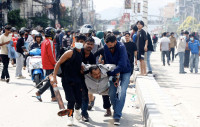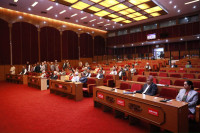Columns
Hydropower (un)economics
Nepal’s hydropower development is challenged by a series of policy confusions.
Achyut Wagle
Nepal appears to be keen on harnessing its huge hydropower potential to realise its dreams of rapid economic growth and prosperity. Demand for clean and renewable energy including hydropower has shot up due to the global urgency of replacing fossil fuel consumption. The South Asian subcontinent, one of the most densely populated areas on earth, requires a massive amount of energy. And Nepal seeks to offset its burgeoning trade deficit by exporting electricity to markets in neighbouring India, Bangladesh, and possibly, China. Nepal’s commercially exploitable hydropower potential is estimated to be 50,000 megawatts.
For this reason, Nepal has attracted substantial investment in the hydropower sector. Over the last one and a half decades, the installed capacity has increased more than fourfold from 600 to 2,600 megawatts. Last year, Nepal started exporting electricity to India during the wet season, earning approximately $100 million. Compared to the import bill, the amount is insignificant; but it has exhibited the feasibility of exporting energy to the international market. The energy sector is highly optimistic as the scope of the Power Trading Agreement signed between Nepal and India in 2014 is being gradually improved, additional transmission infrastructures are being built, and a Nepal-India-Bangladesh electricity wheeling deal draws closer. This is critical as the transmission lines linking Nepal and Bangladesh must pass through Indian territory.
Unwanted overregulation
Despite these fairly attractive “theoretical” possibilities, Nepal’s hydropower development faces bottlenecks due to a series of policy confusions, overlaps and unwanted overregulation at home. According to a recent estimate by the Confederation of Nepalese Industries, an umbrella organisation of the private sector, 13,992 projects that have obtained survey licences are waiting to sign power purchase agreements (PPAs) with the Nepal Electricity Authority (NEA), the government-owned monopoly. These projects being developed by some 240 companies are worth at least $14 billion and have timelines ranging from five to seven years. A PPA is essential to raise capital from the financial market to begin construction.
Barring a few exceptions, no PPA shave been issued to run-of-river projects for the last three years. The NEA allegedly says the creation of the Electricity Regulation Commission and its Bylaws 2019 prevent it from independently issuing new PPAs.Having a commission as regulator is absurd as there is only one buyer, the NEA, for it to regulate. Another reason why PPAs have not been issued is that the National Energy Strategy of Nepal 2013 (revised in 2017) says that the share of run-of-river projects in the total connected electricity cannot exceed 30 percent. At least 215 of the 240 projects seeking PPAs are run-of-river types. The remaining volume of electricity should be a mix of reservoir-based projects and solar and wind plants.
The discrepancies
The “power mix” strategy is assumed to have been designed to limit production to 15,000 megawatts. This goes against the NEA’s plan to export surplus production, and boost per capita electricity consumption to 400 kilowatt-hours by 2024. Another disagreement is that the government wants to purchase and pay for only as much electricity as it wants under the “take and pay” system while private sector developers want the government to guarantee payment for their entire output. Such confusion after issuing the licences and initial investment by the developers in so many run-of-river projects is not desirable. One particular condition in the survey licence contract is of major concern to investors: The promoter must obtain a production permit by completing the PPA and financial closure within five years. Since the government has stopped issuing the PPA, the future of many companies is in doubt and they risk losing their investment.
Nepal’s energy use policy also often lacks basic economic rationale. There is a lot of talk about imminent over-production and possible wastage while per capita energy consumption is yet to cross 350 kilowatt-hours. At least 10 percent of the Nepali population is yet to get an electricity connection. Domestic industry is charged Rs8.40 per unit while the price fetched from day-ahead trading on the Indian Energy Exchange is only Rs4.60. This kind of discrimination contradicts the national policy of supporting industrialisation.
The country has not even considered the amount of electricity it will require when it establishes energy-intensive plants to produce chemical fertiliser and green hydrogen and process metal ores on a commercial scale. The prospects of incorporating electricity wholesale enterprises and enabling domestic power wheeling, for example, power producers in the Karnali basin selling their output in Biratnagar Industrial District, could be some of the options to provide a fillip to Nepal’s hydropower sector.




 8.12°C Kathmandu
8.12°C Kathmandu















